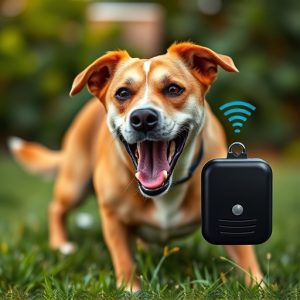Sonic Animal Training Devices: Safety, EMC, and Regulatory Compliance for Dog Repellents
Sonic dog repellents rely on Electromagnetic Compatibility (EMC) certification to ensure safety for…….
Sonic dog repellents rely on Electromagnetic Compatibility (EMC) certification to ensure safety for both pets and humans while preventing interference with electronics. This rigorous testing guarantees these devices emit no harmful radiation, fostering consumer trust in their reliability. Adhering to international standards like FCC and CE certifications, along with local laws, is essential for market acceptance, establishing these repellents as safe, effective, and responsible animal training tools.
“Discover the revolutionary power of sonic animal training devices, designed to protect your home or property without harm to pets or wildlife. This article delves into the science behind these innovative solutions, highlighting their effectiveness in repelling dogs and other animals. We explore the critical role of EMC (Electromagnetic Compatibility) Certification for dog repellent devices, ensuring safety and regulatory compliance. Learn key considerations for implementing sonic deterrents and understand the strict requirements for bringing such products to market.”
- Understanding Sonic Animal Training Devices: How They Work
- The Importance of EMC Certification for Dog Repellents
- Ensuring Safety: Key Considerations for Sonic Animal Deterrents
- Regulatory Compliance and Beyond: Meeting Requirements for Your Device
Understanding Sonic Animal Training Devices: How They Work
Sonic animal training devices are innovative tools designed to protect pets and homeowners from unwanted behavior, such as barking or digging, using sound waves. These devices emit high-frequency sounds that are typically inaudible to humans but can be detected by animals. When an animal triggers the sensor, usually by approaching a certain area, the device activates and emits the sound signal, which serves as a deterrent without causing harm. This technology leverages animals’ sensitivity to specific frequencies to train them to avoid particular behaviors or areas.
The effectiveness of these devices relies on their ability to meet specific EMC (Electromagnetic Compatibility) certification requirements. These certifications ensure that the sonic signals do not interfere with other electronic devices and are safe for both pets and humans. Dog repellent devices, in particular, must adhere to strict guidelines to avoid any potential health risks associated with sound exposure. By ensuring these standards, users can have peace of mind knowing their animal training devices are reliable, safe, and effective.
The Importance of EMC Certification for Dog Repellents
The effectiveness and safety of any electronic device, especially those designed for pet training like dog repellents, heavily rely on Electromagnetic Compatibility (EMC) certification. This certification ensures that the product can operate harmoniously in its intended environment without causing unwanted electromagnetic interference (EMI) to other devices or vice versa. For dog repellents, this is crucial as they often operate near humans and other electronic equipment, like phones or computers.
Obtaining EMC certification for dog repellents involves adhering to specific requirements set by international standards. These standards ensure the device’s performance and safety, guaranteeing that it won’t emit harmful radiation or experience interference from external sources. By meeting these EMC certification requirements, manufacturers can assure consumers of their product’s reliability and safety when used around pets and people alike.
Ensuring Safety: Key Considerations for Sonic Animal Deterrents
Ensuring safety is paramount when introducing sonic animal training devices, especially those designed as dog deterrents. These innovative tools use sound waves to communicate with animals, but their effectiveness and safety must be rigorously evaluated. Reputable manufacturers adhere to strict EMC (Electromagnetic Compatibility) certification requirements to guarantee that their products emit safe sound levels and avoid any potential harm to both pets and humans.
Understanding the EMC Certification Requirements ensures consumers purchase devices that have undergone rigorous testing for electromagnetic interference and radio frequency emissions. This process safeguards against any adverse health effects and confirms the device’s reliability in various environments, making it a crucial step in responsible animal training technology development.
Regulatory Compliance and Beyond: Meeting Requirements for Your Device
When developing a Sonic Animal Training Safety Device, Regulatory Compliance is non-negotiable. This involves adhering to stringent standards set by international bodies like FCC (Federal Communications Commission) and CE (Conformité Européenne) for electronic devices. For your Dog Repellent device, EMC (Electromagnetic Compatibility) Certification is crucial; it ensures your product doesn’t emit harmful electromagnetic radiation and minimizes interference with other devices.
Beyond certification, consider local laws and regulations specific to animal training tools and dog repellents. Each region has its own set of requirements, so thorough research is vital. Ensuring your device meets or exceeds these standards not only guarantees safety but also builds consumer trust, positioning your product as a reliable and responsible offering in the market.
When it comes to developing and marketing a sonic animal training safety device, especially those designed as dog repellents, adhering to strict standards is paramount. Ensuring product safety and effectiveness involves understanding how these devices work, obtaining essential EMC certification for dog repellents, and navigating regulatory compliance. By prioritizing these key considerations, creators can deliver innovative solutions that meet the needs of pet owners while upholding relevant EMC certification requirements.


